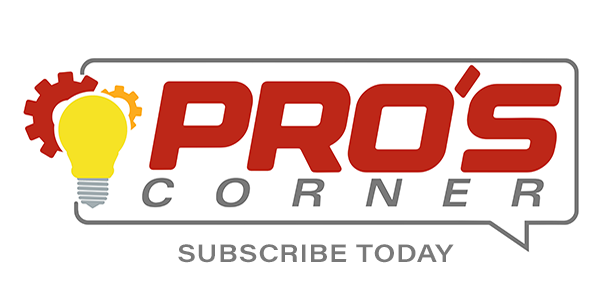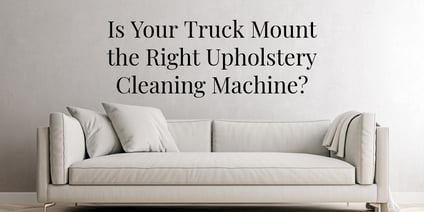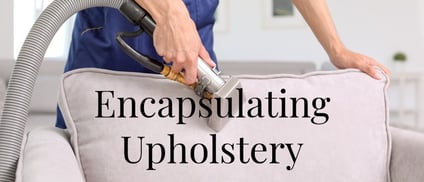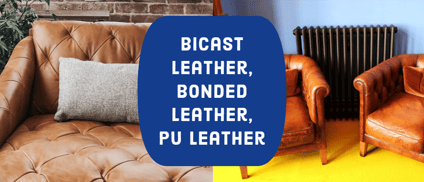The leather market has been steadily growing for the last two decades, with leather accounting for 38 percent of all upholstered furniture sales based on dollar volume.
Worldwide, sales reached $7.9 billion (yes, billion with a B) in 2010. This was followed by a 14 percent gain to about $9 billion in sales in 2011 and $12.45 billion in 2017.
An increasing amount of leather is everywhere from cars to offices to family rooms to hotel lobbies.
And for good reason too: the average piece of leather upholstery lasts for at least ten years, much longer than fabric upholstery.
It's safe to say that learning how to clean leather will ensure you plenty of service opportunities for years to come. The biggest increase is in high-end pieces which are found in the homes and offices of many cleaners' preferred market.
Characteristics to Look For When Identifying Protected Leather
Because protected leather (also known as painted, pigmented, or simply type "P" leather), is easy to clean and accounts for 80 percent of leather being sold, it is a great starting point for those wanting to explore leather cleaning.
Protected leather is an aniline-dyed leather with a heavy pigment coat sealed by a polyurethane resin. It is fairly easy to identify when compared to aniline and nubuck/suede, the two other popular upholstery leather types. Protected leather has consistent coloration resulting from the heavy pigmentation process. Any individual marks on the leather from bug bites, cuts from barbed wire, wrinkles, etc., are covered over.
The use of color not typically found in nature is one more sign of a pigmented coating. If it is still not obvious, you can open a cushion and look for a color difference between the front and back sides of the leather. This test is sometimes misleading, as the pigment on the surface and the dye seen on the back can be too close to show a distinct difference. Sometimes it may have been given a two-tone effect, called Kela or Sauvage, which is usually a black dye rubbed over the base pigment color.
Protected leather feels stiffer than Aniline or Nubuck leather because you are feeling the polyurethane finish rather than the soft surface of naked or aniline leather. It is also cooler to the back of the hand.
If the polyurethane finish is intact, a light scratch with a fingernail will not penetrate the leather surface. Aniline and Nubuck leathers scratch easily to a lighter color.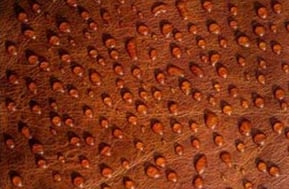
Water drops will absorb into the surface of Aniline and Nubuck leathers even with quality surface protectants, in contrast to water drops on polyurethane coating, which will sit on top of type "P" leather for an extended period of time.
Differentiating protected leather from aniline or nubuck leather is a fairly simple task, however, if you are still unsure what type of leather you are working with you can locate an inconspicuous spot and rub in a drop of leather protector. This will make little or no change to the appearance of protected leather when applied. Aniline leather will darken but later dry clear. Nubuck will darken and stay darker.
How to perform an Inspection of the Leather
Your greatest difficulty will be persuading your customers to clean their leather regularly. Typically, they have been told by a salesman that protected leather is low maintenance, leading them to believe that it never needs to be cleaned.
The truth is that the polyutherane finish of protected leather is 90% polyurethane and 10% plastifiers making it very durable as long as that balance is maintained.
There are multiple chemical processes that can damage the finish. Over time, oils from the body or other sources attack the polyurethane, softening the finish to the point of it being able to be peeled or worn off. Improper cleaning products can also attack the plastifiers, in turn drying the finish and causing it to crack. Peeling and cracking of the finish transform a low-maintenance situation into the need for extensive restoration to repair the damage.
Using the wrong leather cleaner may give an acceptable appearance, but leads to damage over time.
Now that you have identified the leather as protected, you need to closely examine the furniture. Look for split seams, natural marks, stains, and damage to the finish in the form of deep scratches, cracking, and/or peeling. Be sure to examine areas closely where body oils are prone to accumulate. Look for worn areas where some or all of the protective finish is gone. Record any issues on your inspection form. Doing this in the presence of the customer assures you that the problems with the leather remain with the customer.
Damage and wear to the finish are not going to be resolved by cleaning and in some cases will become more noticeable after cleaning. For example, areas impacted with hair oils and body oils can hide damage to the finish.
Cleaning Protected Leather
The old adage, "Pay me a little now, or pay me a lot later" is especially true with protected leather. I know of leather professionals who do not clean leather, but when time and use have taken their course, they are provided with an abundance of restoration business to refurbish protected leather.
As long as the finish is intact, protected leather is the easiest to clean, because you are cleaning the protective polyurethane and not the leather itself.
 Not all leather is tanned the same way. The leather used in upholstery is not the same as the leather used in clothing, purses, or to cover baseballs. Some leather cleaning products such as saddle soap have migrated to our industry but were originally formulated for use on other types of leather.
Not all leather is tanned the same way. The leather used in upholstery is not the same as the leather used in clothing, purses, or to cover baseballs. Some leather cleaning products such as saddle soap have migrated to our industry but were originally formulated for use on other types of leather.
You should select leather cleaning products formulated specifically for upholstery leather and be weary of one-product-fits-all cleaners.
You are now ready for the easiest part of the cleaning process.
1. You can start with industry-standard water-based leather cleaners that produce plenty of foam. Simply apply several drops of cleaner to a sponge dampened with warm water. Foam it up and apply it to the leather in a circular motion. Remove soil released by the cleaner with a clean terrycloth towel.
2. For heavy soils, use a horsehair brush or even super fine steel wool to add additional agitation to aid the cleaning process. Periodically rinse out the sponges to remove collected soil. Heavily used areas may require more than one cleaning pass.
3. On some jobs, you will need to use additional spotters such as specialized solvents and aerosol degreaser, to take out stains that have bonded to the surface of the finish. These can be obtained individually or as part of a complete leather cleaning kit.
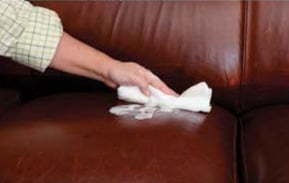 4. You will frequently use a specialized spotter to remove pigments transferred from blue jeans, newsprint, mustard, and other difficult stains. If the protective finish has been degraded, this spotter may remove the stain plus the pigment in the leather and/or the dye used to create the two-tone effect on some leathers.
4. You will frequently use a specialized spotter to remove pigments transferred from blue jeans, newsprint, mustard, and other difficult stains. If the protective finish has been degraded, this spotter may remove the stain plus the pigment in the leather and/or the dye used to create the two-tone effect on some leathers.
The Spotter should always be pre-tested in an inconspicuous place before use. When a less aggressive product is needed, it can be diluted down with distilled water to a ratio as much as 1:4.
Apply this specialized solvent to a soft cloth and let it glide over the surface of the leather. Pressure on the surface of the leather will result in pigment loss.
The solvent will take some time to dwell and begin working. Be patient and continue the light touch as long as you are making progress. Remove as much staining as you safely can without removing pigment, then rinse thoroughly with the water-based cleaner discussed previously.
Other degreasing solvents and aerosols should be used in well-ventilated areas. The liquid solvent is especially effective in removing residual oils from the surface of the leather to prevent long-term accumulation. The aerosol degreaser is sprayed on the leather and allowed to dry for one hour. The staining material is transferred to an absorbent powder. It is then brushed or vacuumed off followed by cleaning/rinsing thoroughly with basic foaming cleaners. This process is a little slow but works great on hair and skin oils not removed by initial cleaning attempts. It also allows you to take care of other tasks while it safely works on difficult oil stains. More than one application may be needed if oils have built up.
If it is necessary to use a degreaser, liquid, or aerosol, first pre-qualify with the customer that the pigment and finish may be damaged by the long-term presence of oil.
If the oil has visibly collected on protected leather, damage has been done to the polyurethane finish.
Ballpoint ink and lipstick can be removed from protected leather if the spotting occurs within a couple of days of the stain. A mild ink remover in solid form (like a tube of lip balm), is rubbed into the ink allowing the stain to be wiped off with a soft clean cloth. Removal of older ink stains will require repeated attempts. Some pigments from the leather may be removed along with the ink.
As with other spotters, you want to finish by rinsing using the foam of a water-based cleaner and a sponge.
For permanent markers or ink that is not being removed with a mild product, use a more aggressive remover for leather.
Finish the Job by Protecting the Leather
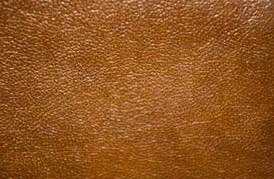 After cleaning it is important to apply a protector to prevent stains from penetrating the leather. This is especially critical for items that get a lot of use, or for where the original polyurethane finish has become worn. The appropriate protector keeps the leather soft and supple rather than becoming stiff with age. A leather protector should be applied every six months for heavily used leather and annually for pieces that get less use.
After cleaning it is important to apply a protector to prevent stains from penetrating the leather. This is especially critical for items that get a lot of use, or for where the original polyurethane finish has become worn. The appropriate protector keeps the leather soft and supple rather than becoming stiff with age. A leather protector should be applied every six months for heavily used leather and annually for pieces that get less use.
The leather needs to be dry before proceeding with the application of leather protection. Air movement will speed drying but It is unnecessary to dry with a hairdryer.
Apply the protector to a soft lint-free cloth and rub evenly over the surface of the leather. If a lot of soil is coming onto the soft cloth you may need to stop and re-clean before you continue. The second coat of leather protector is beneficial for pieces that have accumulated some wear. Allow the final coat to dry naturally without any assistance from the heat or air movement.
If the leather dries tacky, then the protector was applied before the leather was completely dry. Re-clean to remove this tackiness.
You could stop here, but there is one additional service you can offer. Leather requires a revitalizer if exposed to sun, heat, dry climates, heavy use, or age, This re-moisturizes dry leather and gives it a softer feel. Fat liquors, the original oils in the leather from the animal, and the tanning process are replaced. The original supple feel of the leather is restored. The leather will last longer without becoming stiff or cracking. In addition to keeping leather soft, it eliminates squeaky leather-on-leather noises.
Revitalizers should be allowed to dry on their own. This assures penetration from the surface to the back of the leather.
How do I Accurately Price this Type of Job?
Similar to pricing for any cleaning service, there are variations according to the local market and the level of service delivered.
Pricing for the cleaning of protected leather should be divided into maintenance and restorative cleaning. Customers should get their leather cleaned and protected for this price. The application of a revitalizer could also be included in a package price or offered as an option at an additional cost. For routine maintenance cleaning, you should charge 50 percent higher than you would for a similar piece of fabric upholstery. Your fees for restorative cleaning will be significantly higher.
As you become comfortable with the process of cleaning protected leather, you will gain the confidence to take the next steps, cleaning aniline and nubuck leather.
By Scott Warrington
Featured Products

Hydro-Force, Leather Cleaning, Professional Leather Cleaner, 1 Quart
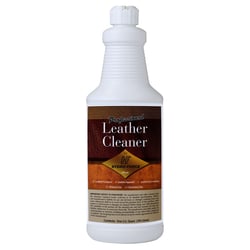
Hydro-Force, Leather Cleaning, Professional Leather Cleaner, 1 Quart

Hydro-Force, Leather Cleaning, Complete Leather Cleaning Kit
Enjoyed reading this post? Read the following articles:

